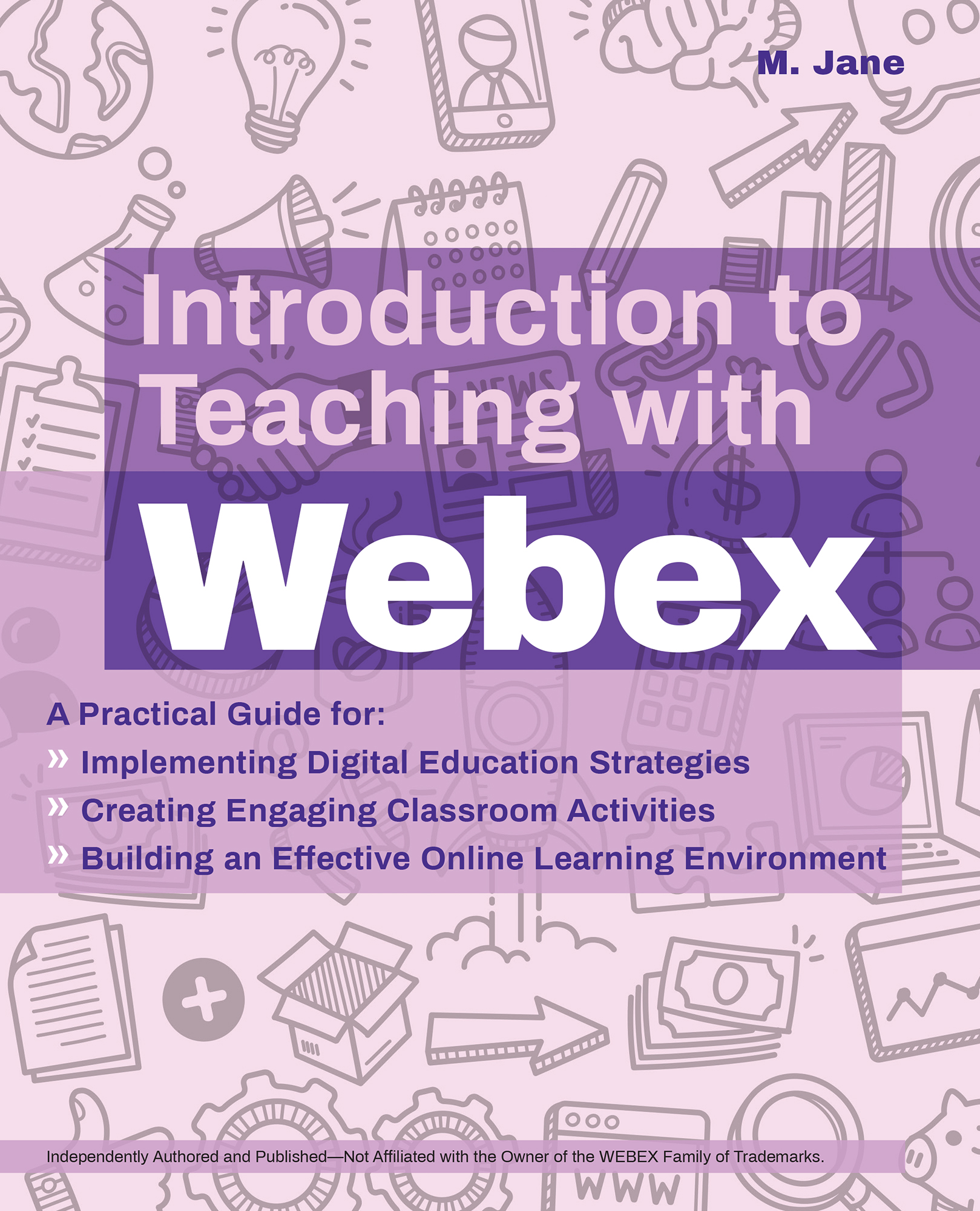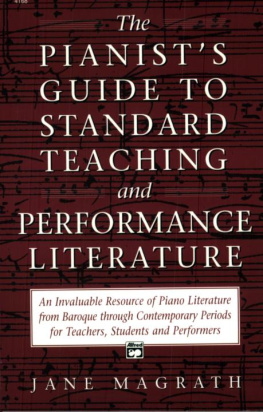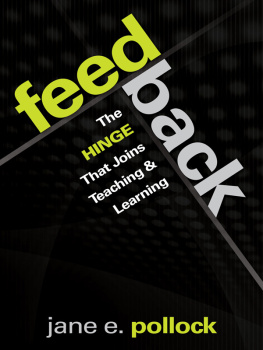M. Jane - Introduction to Teaching with Webex
Here you can read online M. Jane - Introduction to Teaching with Webex full text of the book (entire story) in english for free. Download pdf and epub, get meaning, cover and reviews about this ebook. year: 2020, publisher: Ulysses Press, genre: Home and family. Description of the work, (preface) as well as reviews are available. Best literature library LitArk.com created for fans of good reading and offers a wide selection of genres:
Romance novel
Science fiction
Adventure
Detective
Science
History
Home and family
Prose
Art
Politics
Computer
Non-fiction
Religion
Business
Children
Humor
Choose a favorite category and find really read worthwhile books. Enjoy immersion in the world of imagination, feel the emotions of the characters or learn something new for yourself, make an fascinating discovery.

- Book:Introduction to Teaching with Webex
- Author:
- Publisher:Ulysses Press
- Genre:
- Year:2020
- Rating:4 / 5
- Favourites:Add to favourites
- Your mark:
- 80
- 1
- 2
- 3
- 4
- 5
Introduction to Teaching with Webex: summary, description and annotation
We offer to read an annotation, description, summary or preface (depends on what the author of the book "Introduction to Teaching with Webex" wrote himself). If you haven't found the necessary information about the book — write in the comments, we will try to find it.
M. Jane: author's other books
Who wrote Introduction to Teaching with Webex? Find out the surname, the name of the author of the book and a list of all author's works by series.
Introduction to Teaching with Webex — read online for free the complete book (whole text) full work
Below is the text of the book, divided by pages. System saving the place of the last page read, allows you to conveniently read the book "Introduction to Teaching with Webex" online for free, without having to search again every time where you left off. Put a bookmark, and you can go to the page where you finished reading at any time.
Font size:
Interval:
Bookmark:


Whether you teach, parent, or sit in the students seat, you have undoubtedly encountered the need for digital distance learning. The world is new, and the events of 2020 will forever shape how we view instructional design, curriculum delivery, remote access needs, and virtualization of learning. Teachers prove time and time again that the drive to educate, support, and shape other people into healthy thinkers is the noblest calling, despite the myriad struggles encountered at each political, economic, and social upheaval. Educators soldier onfor the survival and success of our communities. Building lessons, developing and implementing best practices, measuring instruction with equity, and creating classrooms that develop students meaningfully requires skill, experience, and expert craftsmanship.
Master crafters require professional tools, and in an age of socioeconomic shifts, altered classrooms, and dramatically changed public spaces, teachers must be equipped with digital ones.
Digital distance learning, or virtual learning, is the placement of curriculum, lessons, interaction, and materials into a virtual environment. Distance learning falls into two basic camps: repository and interactive.
- Repository distance learning models act mostly as a filing cabinet and drop box. They include posting assignments for students to complete and submit, but they offer limited interaction. Assignments are usually edited by the person who assigned them and submitted through the interface without immediate grades other than a notification of submitted. It then falls to the teacher to organize, grade, and communicate progress. Most repository virtual learning environments are asynchronous, which means learning can be engaged whenever and wherever, because nothing is engaged in real time. Videos are prerecorded, assignments are submitted within large time frames, and the environment is generally made for students to engage on their own schedule.
- Interactive virtual learning environments are more likely to have some synchronous and semi-synchronous elements. This means that there will be livestreamed videos, discussions that are monitored over shorter periods of time, and live virtual collaborations. This is a more productive environment for learners overall, but it also comes with a heavier workload for parents, support people, students, and teachers, as the interaction requires careful scheduling and management of multiple moving parts. (For instance, hosting a virtual meeting with 19 seven-year-olds comes with unique challenges, as does hosting one with bored or distracted adults.)
Best practice typically dictates that your learning environment has a balance of synchronous and asynchronous elements to mimic in-person teaching. A teacher isnt always performing or interactingstudents benefit from having opportunities to apply recently acquired knowledge. Provide guidance for learners on how to apply their synchronous learning to the times they are working independently outside the (virtual) classroom. Digital distance learning means you are providing experiences, instruction, and opportunities for students to apply, wherever they may be.
The future of teaching lies in how we address poverty of space and resources. A poverty of space occurs when there are more students than we can fit into classrooms, or too few classrooms to accommodate adequate social distancing. A poverty of resources occurs when students and teachers cannot access computers, tablets, or internet connections regularly; when materials cannot be purchased; and when there are too few teachers to accommodate many levels of need within their student populations. Digital distance learning is an incredible mitigating factor for these challenges: it addresses both space and resource deficiencies.
Digital distance learning takes up very little physical space. While it does require connectivity and technology for access and engagement, once these barriers are addressed, learning can be diverse, dynamic, and student centered. Students and teachers will of course need a workspace for the development and delivery of digital distance learning, but the classroom space itself is often virtual, cloud-based, and accessible from anywhere. In addition to a variety of interactive resources, digital distance learning makes virtualized curriculum a breeze to embed into online classrooms. Students no longer need to purchase costly and cumbersome textbooksthese can typically be accessed through log-in codes and shared e-book links in a digital environment. Virtual tours of museums, engaging videos, and a plethora of shared (and often free!) resources, and much more, can be housed in a space as small as a computer screen. Connectivity to limitless virtual space dramatically reduces the impact of physical space shortages.
Digital distance learning addresses resource shortages as well. Initially, it may seem cost prohibitive to transition to a robust virtual or hybrid environment, but ultimately, resources that are carefully curated and created will provide learning libraries and curriculum for years to come. Inexpensive devices like Chromebooks are more readily available to students as their price tags diminish; they are becoming as ubiquitous in classrooms now as three-ring binders.
Every grade level can incorporate, utilize, and build curriculum and coursework through online learning. For early elementary students, introductory technology skills can be developed alongside curriculum; for mid-elementary and middle school students, more complex and self-directed learning can help develop independent study skills. Students in secondary, post-secondary, and other continuing education programs can also be served effectively with digital distance/online learning. There are similarities across grade levels for implementation of virtual classrooms and online learning, but there are also a number of differences specific to the level of learning.
Establishing a routine is essential for all grade levels. Ensuring that your students, regardless of age or ability, know precisely what to expect in terms of the format and structure will set them up for success; it will also diminish the stress associated with learning a new platform or navigating a new virtual classroom.
For early elementary students, the amount of time spent in synchronous learning should be carefully measured. Students who require help navigating their technology (log ins, website searches, typing) rely largely on support in their home environments. While many virtual classrooms are set up to develop independence in young learners, it is vital to assess the level of technological comfort not only for the students, but for their support systems as well. In multigenerational homes, students will face competition for resources based on the homes hierarchy of needs: parents working remotely may have the primary need for the family computer, and grandma may be an expert in babysitting but have less-than-modern tech skills. The students home environment, their comfort with and access to technology, and the specific objectives for your class itself are all incredibly important factors to consider when developing virtual learning on any platform.
Think about sending out a technology needs assessment. Using a brief survey, ask your class about their home tech gear and their internet connection and availability. Perhaps you can offer them local resources. Many school districts, cities, and counties provide free and low-cost internet access, as well as options for purchasing computers and other devices. Determine what level of tech will effectively work for your learners grade level: a tablet may suffice for a second grader, but a high school student should have at minimum a Chromebook for typing, emailing, and researching.
Font size:
Interval:
Bookmark:
Similar books «Introduction to Teaching with Webex»
Look at similar books to Introduction to Teaching with Webex. We have selected literature similar in name and meaning in the hope of providing readers with more options to find new, interesting, not yet read works.
Discussion, reviews of the book Introduction to Teaching with Webex and just readers' own opinions. Leave your comments, write what you think about the work, its meaning or the main characters. Specify what exactly you liked and what you didn't like, and why you think so.











